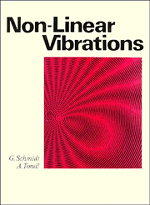Book contents
- Frontmatter
- Preface
- Contents
- Introduction
- 1 Basic properties and definitions
- 2 Methods of solution
- 3 Auxiliary curves for analysis of non-linear systems
- 4 Analysis in the phase plane
- 5 Forced, parametric and self-excited vibrations
- 6 Vibrations of systems with many degrees of freedom
- 7 Investigation of stability in the large
- 8 Analysis of some excited systems
- 9 Quenching of self-excited vibration
- 10 Vibration systems with narrow-band random excitation
- 11 Vibration systems with broad-band random excitation
- 12 Systems with autoparametric coupling
- Appendix
- Bibliography
- Index
1 - Basic properties and definitions
Published online by Cambridge University Press: 10 May 2010
- Frontmatter
- Preface
- Contents
- Introduction
- 1 Basic properties and definitions
- 2 Methods of solution
- 3 Auxiliary curves for analysis of non-linear systems
- 4 Analysis in the phase plane
- 5 Forced, parametric and self-excited vibrations
- 6 Vibrations of systems with many degrees of freedom
- 7 Investigation of stability in the large
- 8 Analysis of some excited systems
- 9 Quenching of self-excited vibration
- 10 Vibration systems with narrow-band random excitation
- 11 Vibration systems with broad-band random excitation
- 12 Systems with autoparametric coupling
- Appendix
- Bibliography
- Index
Summary
Non-linear vibration, non-linear characteristics and basic definitions
As mentioned in the Introduction, vibration of linear systems is only a special case of vibration of non-linear systems. Two important principles, which are valid for linear systems, do not apply to non-linear systems:
(I) The principle of superposition,
(II) The principle of proportionality.
In linear systems described by linear differential equations (all terms are functions of dependent variables and their derivatives) the response to the various components of excitation can be added up; if the amplitude of harmonic excitation is increased n times, the amplitudes of steady vibration increase n times. It has been found advantageous to divide linear vibration into two large groups:
(a) Vibration of systems with constant parameters described by linear differential equations with constant coefficients. The term linear vibration is usually understood to mean vibration of systems of just this type. The theory of this vibration is essentially complete and will not be discussed in the present book.
(b) Vibration of systems with non-constant parameters described by linear differential equations whose coefficients are generally functions of a dependent variable, chiefly time. An important separate group is formed by systems whose parameters are periodic functions of a dependent variable. Such systems are called rheo-linear and their theory is usually studied together with that of non-linear vibration. One of the reasons for this is the fact that an investigation of stability for small disturbances of steady periodic solutions of non-linear differential equations generally leads to an investigation of stability of the trivial solution of systems of differential equations with periodically variable coefficients.
Information
- Type
- Chapter
- Information
- Non-linear Vibrations , pp. 12 - 34Publisher: Cambridge University PressPrint publication year: 1986
Accessibility standard: Unknown
Why this information is here
This section outlines the accessibility features of this content - including support for screen readers, full keyboard navigation and high-contrast display options. This may not be relevant for you.Accessibility Information
- 1
- Cited by
